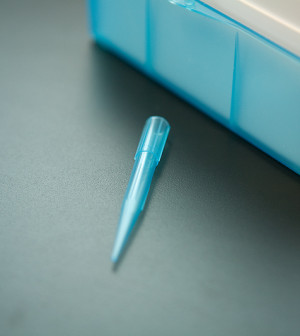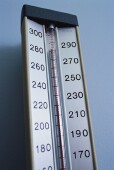- Navigating Your Midlife Crisis: Embracing New Possibilities
- City Raccoons Showing Signs of Domestication
- Mapping the Exposome: Science Broadens Focus to Environmental Disease Triggers
- One Week Less on Social Media Linked to Better Mental Health
- Your Brain Changes in Stages as You Age, Study Finds
- Some Suicide Victims Show No Typical Warning Signs, Study Finds
- ByHeart Formula Faces Lawsuits After Babies Sickened With Botulism
- Switch to Vegan Diet Could Cut Your Greenhouse Gas Emissions in Half
- Regular Bedtime Does Wonders for Blood Pressure
- Dining Alone Could Mean Worse Nutrition for Seniors
Wearable, Doc-Prescribed Monitors May Help Spot High Blood Pressure


People suspected of having high blood pressure may soon be asked to wear what’s known as an “ambulatory” blood pressure monitor for a day or so to confirm the diagnosis, according to draft recommendations issued by the U.S. Preventive Services Task Force.
Ambulatory blood pressure monitoring involves a blood pressure cuff worn constantly around the upper arm, and an attached monitoring device. The cuff automatically inflates at regular intervals, providing a more complete picture of how blood pressure fluctuates. The data is stored in the device and later downloaded, explained Margaret Piper, a senior investigator at the Kaiser Permanente Center for Health Research.
Patients are also asked to keep a diary of their activity during the day, and doctors use data from the monitor and the diary to weigh whether a person truly has high blood pressure.
The data gathered by wearing a monitor throughout a person’s daily routine was up to 40 percent better at predicting future heart attacks, strokes and heart disease than individual blood pressure checks done in a doctor’s office, said Piper. Piper is also the lead author of the evidence review.
“We found that the ambulatory blood pressure monitoring did a better job of predicting future events, and it’s more accurate at predicting the population of patients who would benefit from treatment,” Piper said.
The review was published online Dec. 22 in the Annals of Internal Medicine.
A second study in the same issue of the journal found that people with even mild high blood pressure benefit from taking blood pressure-lowering medicine.
Both studies are important, given that deaths from high blood pressure increased almost 40 percent between 2001 and 2011, said Dr. Elliott Antman, an associate dean of clinical and translational research at Harvard Medical School and president of the American Heart Association.
“About a third of adults in the United States have high blood pressure,” said Antman, who was not involved with the study. “We need to get on top of this now.”
If the task force recommendation becomes final, health insurers would be required to pay for ambulatory blood pressure testing. Under the Affordable Care Act, preventive procedures approved by the task force must be covered.
Patients who experience “white coat syndrome” stand to benefit most from the change, Antman said. Such patients become “very nervous and their blood pressure becomes unusually elevated in the presence of a medical environment,” which can lead to a false diagnosis of high blood pressure.
White coat syndrome may affect as many as 30 percent of people with suspected high blood pressure, Piper said.
Other people who might benefit include people who had a single bad test and people close to the threshold of high blood pressure, she said.
“That way, you don’t treat the people who wouldn’t benefit from treatment and might actually be harmed by it,” Piper said. “It’s going to refine the initial screen performed in a doctor’s office, and give you more accurate results.”
Another group of patients that might benefit are those who react the opposite way. These people may have lower pressure at the doctor’s office than at home, said Dr. Kim Allan Williams, chief of cardiology at Rush University Medical Center and president-elect of the American College of Cardiology.
“Some people’s blood pressure is naturally higher at home,” Williams said. “They take their medicine when they know they’re coming to the doctor, or they have a lot of social stress at home.”
Ambulatory monitors have been around for some time now, Antman said, adding that new versions are easier to use than ever. Some cuffs now wirelessly connect to a patient’s smartphone, so they don’t have to carry a clunky monitor around.
Piper stressed that ambulatory blood pressure monitoring is not the same as self-monitoring performed at home by patients. In self-monitoring, patients choose when they will perform their blood pressure check, using a device they’ve purchased themselves.
“We had data for self-monitoring that seemed to follow the same pattern as ambulatory monitoring, but there were far fewer studies, so we didn’t feel we had enough data to draw conclusions,” she said.
The public can comment on the task force’s draft recommendation between now and Jan. 26.
Getting a correct diagnosis of high blood pressure is clearly important. The second blood pressure study found that people with early high blood pressure who took medication lowered their risk of stroke by almost 30 percent. They also cut risk of heart-related death by 25 percent, and their risk of heart failure by 20 percent, according to the study.
Antman and Williams said the results of the medication study are encouraging, but that patients should first adopt lifestyle changes before taking medication. Such changes might include exercising more, losing weight, and eating a healthier diet that cuts back on cholesterol, simple carbohydrates and sodium.
“I take this as more evidence to support the concept that lower is better, especially if you can get there with means other than drugs and using as little drugs as necessary,” Williams said.
More information
For more on lowering blood pressure, visit the American Heart Association.
Source: HealthDay
Copyright © 2025 HealthDay. All rights reserved.










